Polynucleotides - Study guides, Class notes & Summaries
Looking for the best study guides, study notes and summaries about Polynucleotides? On this page you'll find 64 study documents about Polynucleotides.
Page 3 out of 64 results
Sort by
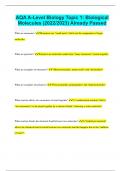
-
AQA A-Level Biology Topic 1: Biological Molecules (2022/2023) Already Passed
- Exam (elaborations) • 25 pages • 2024
- Available in package deal
-
- $8.99
- + learn more
What are monomers? Monomers are *small units* which are the components of larger molecules. What are polymers? Polymers are molecules made from *many monomers* joined together. What are examples of monomers? *Monosaccharides, amino acids* and *nucleotides* What are examples of polymers? *Polysaccharides, polypeptides* and *polynucleotides* What reaction allows two monomers to bond together? A *condensation reaction* allows *two monomers* to be joined together by a chemical bond, *releasing...
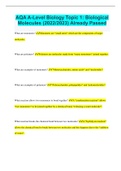
-
AQA A-Level Biology Topic 1: Biological Molecules (2022/2023) Already Passed
- Exam (elaborations) • 25 pages • 2023
-
Available in package deal
-
- $9.99
- + learn more
AQA A-Level Biology Topic 1: Biological Molecules (2022/2023) Already Passed What are monomers? Monomers are *small units* which are the components of larger molecules. What are polymers? Polymers are molecules made from *many monomers* joined together. What are examples of monomers? *Monosaccharides, amino acids* and *nucleotides* What are examples of polymers? *Polysaccharides, polypeptides* and *polynucleotides* What reaction allows two monomers to bond together? A *condensation reaction*...
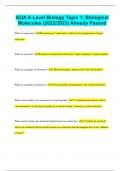
-
AQA A-Level Biology Topic 1: Biological Molecules (2022/2023) Already Passed
- Exam (elaborations) • 25 pages • 2024
- Available in package deal
-
- $8.99
- + learn more
What are monomers? Monomers are *small units* which are the components of larger molecules. What are polymers? Polymers are molecules made from *many monomers* joined together. What are examples of monomers? *Monosaccharides, amino acids* and *nucleotides* What are examples of polymers? *Polysaccharides, polypeptides* and *polynucleotides* What reaction allows two monomers to bond together? A *condensation reaction* allows *two monomers* to be joined together by a chemical bond, *releasing...
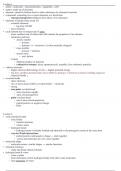
-
MCDB 6 midterm 1 review study guide biology
- Class notes • 5 pages • 2023
- Available in package deal
-
- $3.99
- 1x sold
- + learn more
This document is about the course MCDB 6 midterm 1 study guide.
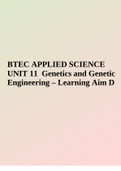
-
BTEC APPLIED SCIENCE UNIT 11 Genetics and Genetic Engineering – Learning Aim D
- Exam (elaborations) • 17 pages • 2023
-
- $15.99
- + learn more
BTEC APPLIED SCIENCE UNIT 11 Genetics and Genetic Engineering – Learning Aim D. A phosphate group, a sugar, and a base are the three components of a nucleotide. (“What are the three components of a nucleotide - B”) They are sugars and bases that make up DNA and RNA. An organic molecule is referred to as a base. Purines and pyrimidines are the two types of bases. Purines are adenine and guanine, while pyrimidines are thymine, uracil, and cytosine. (“Expand ATP class 12 biology CBSE”...
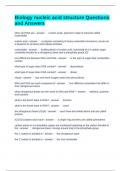
-
Biology nucleic acid structure Questions and Answers
- Exam (elaborations) • 5 pages • 2024
-
Available in package deal
-
- $13.49
- + learn more
Biology nucleic acid structure Questions and Answers DNA and RNA are nucleic acids, polymers made of subunits called nucleotides nucleic acid a polymer consisting of many nucleotide monomers; serves as a blueprint for proteins and cellular activities 0:12 / 0:30 nucleotides building block of nucleic acid, consisting of a 5 carbon sugar covalently bonded to a nitrogenous base and a phosphate group (G) one difference between RNA and DNA is the type of sugar their nuc...
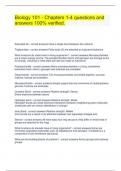
-
Biology 101 - Chapters 1-4 questions and answers 100% verified.
- Exam (elaborations) • 7 pages • 2024
- Available in package deal
-
- $10.99
- + learn more
Biology 101 - Chapters 1-4 questions and answers 100% verified. Saturated fat - correct answers.Have a single bond between the carbons Triglycerides - correct answers.Fatty acids (3) are attached to a glycerol backbone What functions do carbs have in living organisms? - correct answers.Monosaccharides are a major energy source. The polysaccharides starch and glycogen are storage forms for energy. Cellulose is what plant cell wall are made of (structure) Polysaccharide - cor...

-
Test Bank for Cell and Molecular Biology Concepts and Experiments 8th Edition Karp | Complete A ll Chapters 2024/2025
- Exam (elaborations) • 122 pages • 2024
-
- $30.49
- + learn more
Which of the groups below is capable of only hydrophobic interactions? a) A b) B c) C d) D e) E Answer: e Difficulty: Medium Learning Objective: LO 2.3 Describe the role of noncovalent bonds in the structure of molecules such as water. Section Reference: Section 2.3 Noncovalent Bonds 2) Which of the following groups is capable of only hydrophilic interactions? d. H H C C C H H H H e.. H a.. OH b. C C C C C H H SH H H H H H H H H CH C C H H H H H NH 2 c.. C CH3 CH2 ...
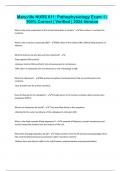
-
Maryville NURS 611: Pathophysiology {Exam 1} 100% Verified 2024 Version
- Exam (elaborations) • 16 pages • 2024
-
Available in package deal
-
- $8.49
- + learn more
Maryville NURS 611: Pathophysiology Exam 1 | 100% Correct | Verified | 2024 Version What is the main component of the cell and what does it contain? - The nucleus; it contains the nucleolus What is the nucleolus composed of(4)? - RNA, Most of the cellular DNA, DNA-binding proteins, & histones What do histones do and why are they important? - They regulate DNA activity. -Histones bind to DNA and fold it into chromosomes for cell division. -DNA chain in eukaryotic cells are extensive so ...
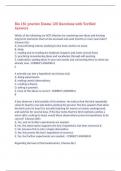
-
Bio 181 practice Exams 120 Questions with Verified Answers,100% CORRECT
- Exam (elaborations) • 36 pages • 2024
-
- $11.49
- + learn more
Bio 181 practice Exams 120 Questions with Verified Answers Which of the following are NOT effective for mastering new ideas and forming long-term memories that can be accessed and used months or even years later? (choose ALL) A. Concentrating intense studying to the hours before an exam. B. sleep C. reading and re-reading the textbook chapters and notes several times D. practicing remembering ideas and vocabulary through self-quizzing E. elaboration: putting ideas in your own words and...

How much did you already spend on Stuvia? Imagine there are plenty more of you out there paying for study notes, but this time YOU are the seller. Ka-ching! Discover all about earning on Stuvia


